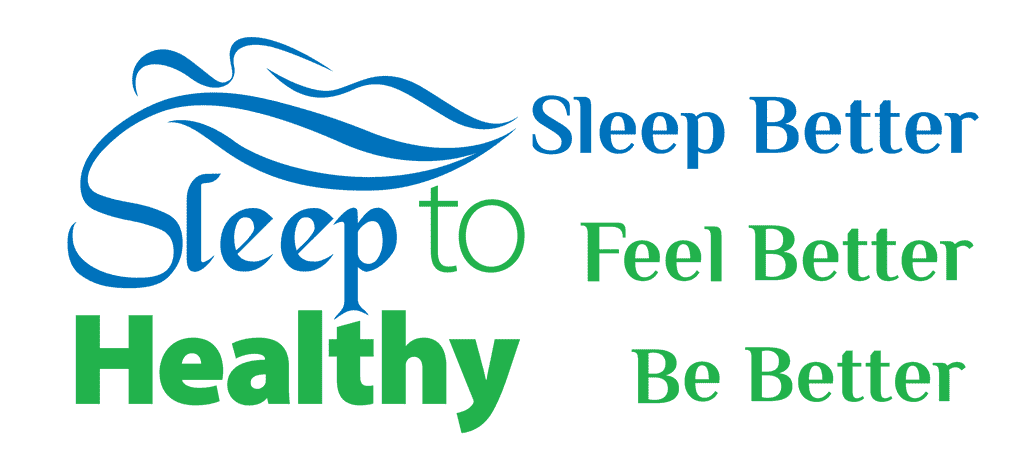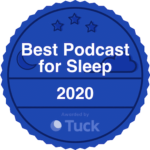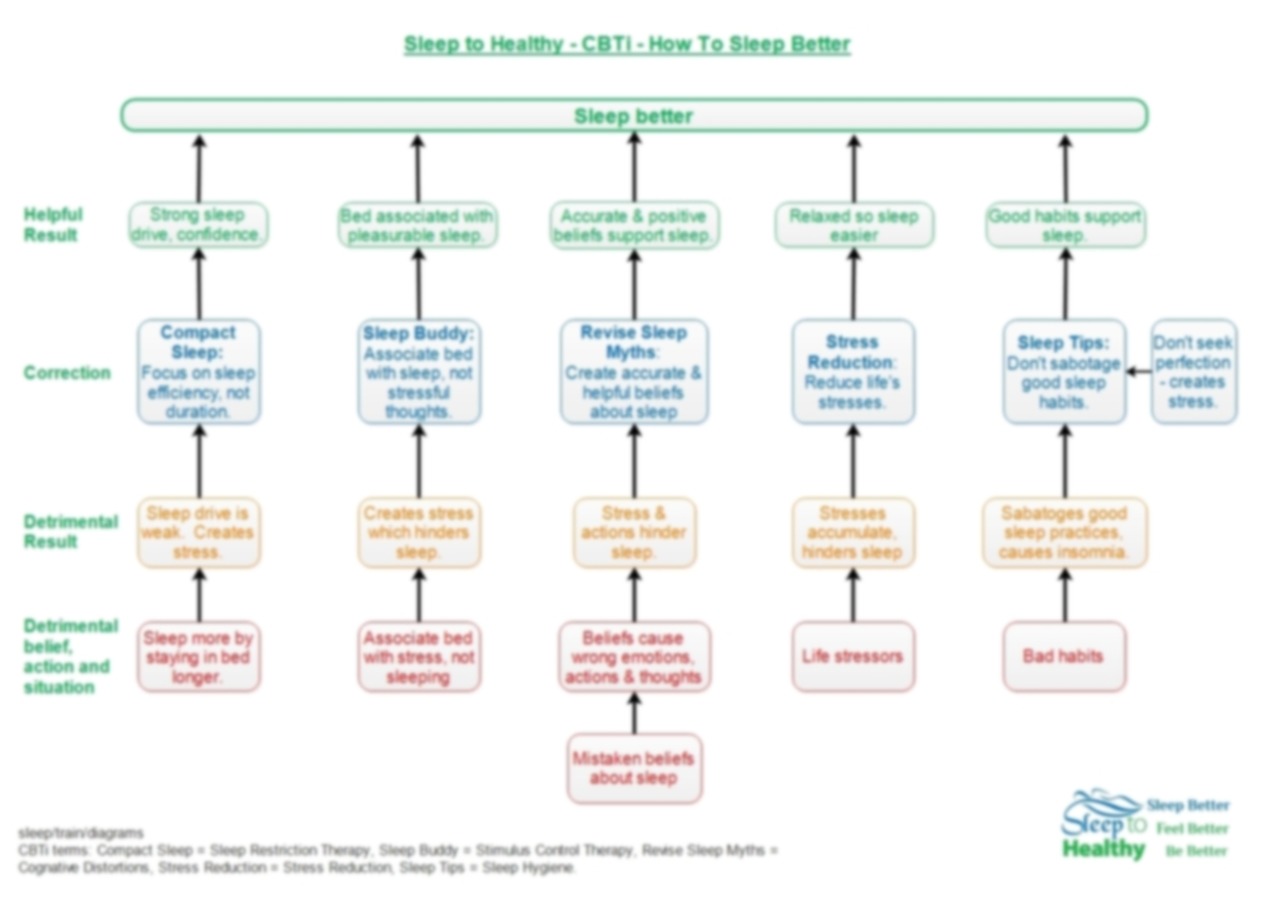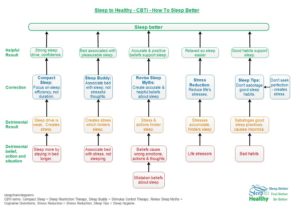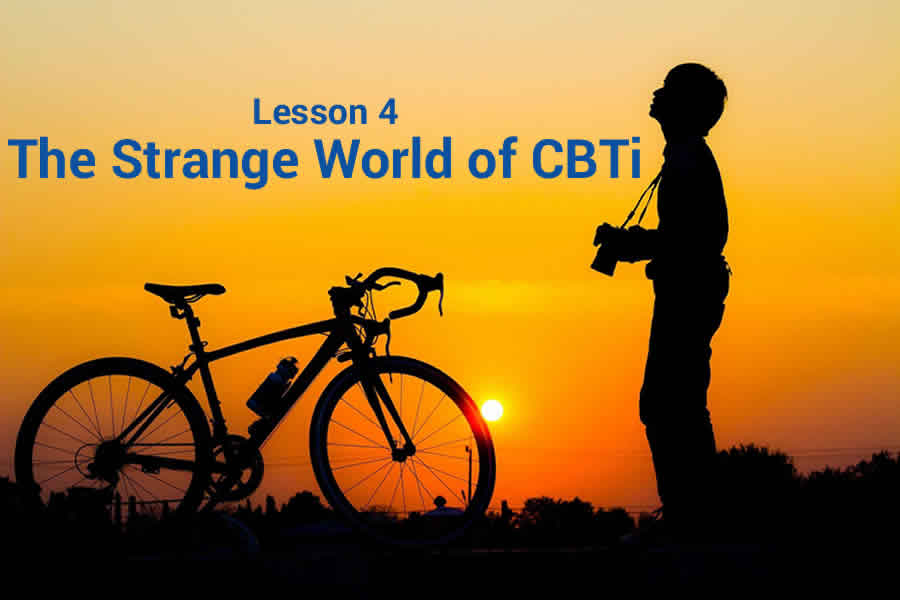
Lesson 4
Cognitive Behavioral Therapy for Insomnia (CBTi)
(You have access to two formats, feel free to use either one.)
Listen
Lesson 4: CBTi
Watch
Lesson Summary:
- CBTi or Cognitive Behavioral Therapy for Insomnia can seem strange because its methods are sometimes counter-intuitive. But it will give you things to help you sleep.
- In this course we use terms that are easier to understand than the CBTi technical terms. We will learn how to cure insomnia.
- CBTi or Cognitive Behavioral Therapy for Insomnia is highly respected and most recommended by sleep specialists. Helps if you think “I can’t sleep” or “Do I have insomnia?”
- Make sure you have any insomnia causing issues dealt with 1st and consult your health professional before trying CBTi.
- The basis for CBTi: Detrimental thoughts and beliefs lead to incorrect behaviors that lead to undesired outcomes.
- There are 5 Cognitive Behavioral Therapy elements for insomnia.
- #1: Compact sleep – Spend your time in bed sleeping, not being awake.
- #2: Sleep Buddy – Creating a strong association between your bed and sleep. Not feeling stressed when you go to sleep.
- #3: Sleep Myths – Corrects the detrimental thoughts and beliefs you have about sleep.
- #4: De-stressing – Learn how to destress to let sleep come easily.
- #5: Sleep Tips – Helpful advice to avoid sabatoging your CBTi skills.
These form the elements of CBT Therapy for Insomnia.
Assignment:
- Go through the 5 Cognitive Behavioral Therapy Elements elements and decide which one you think you should tackle first.
- Review your sleep journal(s) and see what insights or trends you notice. Keep in mind what you learned this lesson and the elements of CBT therapy.
- Send me a message: Text or voice mail at 408-909-8866 or email me at dennis@sleeptohealthy.com or use the Contact page form to let me know what you are learning that is most helpful so far.
Infographic:
Bonus: Exclusive CBTi infographic ties the key concepts together. You learn faster and better.
All I ask in return is that you give me some feedback on this course. Your comments are essential for me to improve the course so you and others can cure your insomnia faster and better. Your help is greatly appreciated.
Of course I will respect your email and not use it for anything other than to send you the infographic.

Podcast Transcript
Hello, welcome to the Sleep…. to Healthy Podcast. I’m your instructor Dennis Trumpy, and this is lesson #4 of the sleep to healthy, how to cure insomnia, class. This lesson is titled “The Strange World of CBTi”. In the last lesson we learned about insomnia, how you developed your insomnia and some initial things you can do to start sleeping better. In today’s lesson we are going to cover the 5 elements of CBTi training so you have a roadmap of the weeks ahead and can see better how everything fits together.
Read More on Cognitive Behavioral Therapy for Insomnia...
The method this course is based on called CBTi or Cognitive Behavioral Therapy for Insomnia. The name is technical, but the methods are very hands on as you will learn to appreciate. I have taken the liberty in this course to rename some of the terms to more user friendly, familiar terms. I will tell you the proper technical term along with the more familiar term so you can communicate clearly with health professionals or find what you are looking for on the web more easily. In this lesson we will introduce you to the strange world of CBTi. I call it strange because some of the practices are quite counter-intuitive unless you understand how your sleep system works and how you have sabotaged it in your efforts to cure your insomnia.
CBTi is well recognized by sleep professionals as a highly effective way to tackle insomnia. For instance, The American Academy of Sleep Medicine did two systematic reviews looking at a total of 85 clinical trials. Both reviews concluded that CBTi leads to significant improvements in getting to sleep and staying asleep. The National Institute of Health expert panel on insomnia released a Consensus Statement recognizing CBTi as the first-line treatment for insomnia. In addition the British Association of Psycho-pharmacology has also issued a statement recommending CBTi as a front-line treatment for insomnia.
As you can see, this is a method firmly grounded in science and a method you can trust to help you sleep better. It doesn’t mean the methods are easy. Just effective.
If you are considering using CBTi to cure your insomnia, you should make sure any true causes of insomnia are dealt with first as reviewed in detail in the last lesson. For instance, if you suffer from obstructive sleep apnea, you can practice CBTi until the cows come home, and its not likely that you will get good, restorative sleep. Your health care provider is the best person to help you unravel any physical, medical, chemical, psychological or other causes of insomnia, so make sure you consult with them 1st.
CBTi, or Cognitive Behavioral Therapy for Insomnia, is based on a simple but profound premise:
Thoughts and beliefs lead to behaviors which lead to outcomes which may or may not be helpful. I will repeat that: Thoughts and beliefs lead to behaviors which lead to desirable or undesirable outcomes. There is a diagram at sleeptohealthy.com that might help you visualize this concept. In real terms, if your thought is inaccurate, then your behaviors will be inappropriate and the outcome will not be what is helpful with your insomnia. This is the basic elements of CBT Therapy.
In terms of insomnia, this means that if you have an inaccurate belief about sleep, you will take the wrong action and the result will be continued or worsening insomnia. Let me give you a couple of examples close to the heart of CBTi.
Let’s say you have a poor night’s sleep. You thought might be “I slept poorly last night, so I will make up for it tonight”. Your action might be to go to sleep earlier to get more sleep. The result will likely be to make your sleep issue worse, rather than better. Why? Because when you go to sleep earlier than usual, your circadian rhythm has not prepared your brain for sleep, and you haven’t been up long enough for your sleep drive to be strong, concepts discussed in lessons 2 and 3. The result will be that you will likely sleep poorly again. The wrong thought lead to a wrong action lead to an undesired outcome. Then, using the same logic, you might try to go to bed even earlier the following night making the problem even worse.
Or as another example, let’s say you wake up at night and can’t get back to sleep. Your belief is that you should stay in bed and force yourself back to sleep. This creates added stress and anxiety, which we learned in earlier lessons, is the #1 enemy of sleep. On top of that, you are training yourself that bed isn’t for sleep, it is a place where you have unpleasant experiences of fretting about your sleep. When these two outcomes are combined, the result is that you don’t get back to sleep and you have a worse night’s sleep than you might have. The wrong thought lead to a wrong action lead to an undesired outcome. Thought, action, outcome.
If you remember only one thing from this lesson, remember that mantra – thought, action, outcome. CBTi cuts to the chase by focusing on the wrong beliefs so you take the right actions and have the right outcomes. This is the cognitive behavioral therapy elements.
There are 5 elements to CBTi: Compact Sleep, Sleep Buddy, Sleep myths, de-stressing, and sleep tips. Each of these elements will be given its own in-depth lesson, but I will give a brief overview now, so you have an idea of what lies ahead, how the different elements fit together and to help reinforce the concepts.
If you go to my website, sleeptohealthy.com, I will send you a infographic showing the 5 CBTi elements in a way that helps you see how everything fits together. It will illustrate what caused your wrong strategy to tackle your insomnia, why that wrong action of yours perpetuates your insomnia, what the corrective action is, and why the result will cure your insomnia. This is like a cheat sheet that can help you as you implement CBTi training. This chart is not available anywhere else on the internet so I encourage you to download it at sleeptohealthy.com.
When you were a baby, nobody had to teach you how to sleep. Even as a child and young adult you probably slept well without going to sleep school. But at some time in your life, you picked up some mistaken beliefs that lead to poor choices and bad outcomes that you now call insomnia. The hopeful thing is that you can undo the whole process. Fix your mistaken beliefs so you can take better actions with the outcome of improved sleep. Sound promising? Even better news is that this new wisdom will last you a lifetime. If you regress, then you can go back to this podcast for a refresher and get back on the right track. I do it all the time. It takes a while to make it all work the 1st time, but once you master the techniques, relearning it is a snap.
Just a warning: You can expect to regress from time to time from your progress meaning that even after you are successful at restoring your sleep, you will find times when you fall into bad habits once again. This is perfectly normal. Psychologists call this extinction meaning that we naturally fall back into previous patterns even after we think we have developed a new, better habit. But now you will have the tools and confidence to pin point the problem and take corrective action to get your sleep back on track. These are the cognitive behavioral therapy elements.
So let’s dive into the 5 elements of CBTi or Cognitive Behavioral Therapy for Insomnia, shall we.
The first element of CBTi is Compact Sleep. This is the most technical of the CBTi elements, but don’t be discouraged if you are not a rocket scientist, because the concept is nothing new to you. Compact Sleep just means that when you are in bed you should be sleeping, not laying awake. Sounds pretty obvious, doesn’t it. But if you have insomnia, you likely spend a significant amount of time in bed not sleeping. This is the example I gave earlier where the mistaken belief is that if we sleep poorly we should stay in bed longer to make up for the lost sleep. When we tackle compact sleep, we are going to make it clear why staying in bed longer to sleep better is a very bad strategy and exactly what to do about it. I will cover compact sleep in the next lesson.
It is a bit technical because you have to do some calculations to measure how compact your sleep is. But not to worry. Go to my website sleeptohealthy.com, and you will find a calculator that does all the math for you. I don’t want you to loose any sleep over it. <4goan>
In that lesson we are going to learn more about why extending your time in bed perpetuates your insomnia and what to do about it.
Making your sleep more compact is hard work because it forces you to stay up when you want to go to sleep and get out of bed when you want to sleep in, at least for a while until you get back on track.
Daniel – II #1 – 0:10 – most powerful part of CBTi, exploit sleep drive, hungry and elements of cbt therapy.
In the CBTi world compact sleep is referred to as Sleep Restriction Therapy. I gave it a new name because the formal name is not accurate, creates fear in the hearts of insomniacs and it is hard to remember. See why I changed the name?
Second on the list is Sleep Buddy, which normally goes by the ominous sounding name of Stimulus Control Therapy. Again, I think you can see why I changed the name.
Your relationship with sleep should be more like your relationship with a friend than an object. Think of someone that rubs you the wrong way, someone that you just don’t get along with. Someone who, every time to are with them, results in you having negative feelings such as anger, impatience, frustration, awkwardness, fear or disrespect. It is very hard to feel at ease when you are around this person. You can hardly imagine how anyone else can stand them. For you, they are a stress trigger.
But even though you have a distaste for this person, there are others who like this person. This person has friends. They have relatives such as a mother, a father, a sibling, or another relative who enjoys their company and appreciates them. Other people such as customers, teammates or fellow staff members probably like this person. The fact that others like this person means that the stress that you feel is your own reaction to this person, not an absolute quality of the person. It isn’t that the person has the quality of unlikability, it is that you have developed an aversion to this person and you react with stress. Over time you have created negative associations with this person while someone else has created positive associations.
Now we are going to take a leap from this person to your bed.
What do you think of your bed and sleep? When you are in your bed do you relax and naturally drift into a deep and restful sleep? Or do you have negative associations? Perhaps you dread at bedtime. Perhaps you are worried about what will happen tonight, the long bouts of being awake at night. Maybe as you lie in bed you anticipate how crappy you will feel tomorrow morning and all day long.
Your bed can trigger uncomfortable feelings and reactions from you whereas a good sleeper has a great relationship with their bed and their sleep. Do you see the parallel? You can build up associations with an object or a person that causes you stress. You might not even be aware of it. In the same way you can build up negative associations with your sleep and your bed that triggers stress.
Here is a thought experiment that should give you hope about your relationship to sleep.
Think back to the person you imagined earlier, the one who irks you so. What if you found out the root of why they annoy you. Perhaps they had a traumatic childhood and now they struggle to cope in the world. Perhaps they have a mental illness beyond their control that makes it hard to communicate the way you like. Perhaps they had a traumatic experience such as going to war or living in a violent neighborhood that permanently scarred their brain. Can you feel your negative association with them start to melt, if even a little bit?
Sleep Buddy is all about realigning these uncomfortable reactions you have with your bed & sleep until your bed becomes a refuge, and sleep something you look forward to each night. It may sound far-fetched to you now, but give me a chance in lesson #6 & #7 and let’s see if we can’t change that relationship for you.
These first 2 elements, Compact Sleep and Sleep Buddy are the hardest, but also the most effective elements of CBTi or Cognitive Behavioral Therapy for Insomnia that this course relies on. They are hardest because you must change your behaviors. You will likely find the changes uncomfortable and difficult to implement. I don’t tell you this to discourage you, but to help you prepare mentally to improve your chances of success and so you can tackle them with less stress. Also, it is good to know that after you get through the first 2 elements of CBT therapy, the rest is downhill.
Sleep Myths is number 3 of the cognitive behavioral therapy elements. It hits at the heart of the belief – action – outcome system that I talked about earlier. In this case, the beliefs and things you tell yourself about sleep that leads you into trouble. We’ll explore many incorrect thoughts and beliefs that you have and how to correct them. Many of these false beliefs are perpetuated by the media, so you will have to be strong and firm in your newfound beliefs to avoid being unduly influenced by media hype about sleep. As an example, probably the biggest myth that we learned in lesson #2 and #3 was the 8 hour sleep myth – that you should aim for 8 hours sleep a night. We learned that our goal should be to feel well rested and alert during the day, not to aim for any particular sleep time. I will give a refresher on this concept and introduce many more in concepts lesson #7 and tell you what to do about them.
One of the key sleep myths is sleep effort – the belief that you can improve your sleep by trying harder: This is what Michael Schwartz has to say about that:
<Michael audio: Sleep efforts, hard to go through insomnia, efforts increase insomnia, makes it worse>
The CBTi lexis for Sleep Myths is Cognitive Distortions.
Number 4 is de-stressing techniques. Basically, enemy number 1 for sleep is stress and anxiety. Sleep and stress and anxiety go together like water and oil, or maybe more like fire and the wood frame of a house. We know who wins that fight. De-stressing relies on meditation and other techniques to help reverse the stress that builds up during the day. You might already do some meditation which is great. Or you might have an aversion to meditation, in which case I will give you alternative approaches to be calm and relaxed and ready for sleep. I will give you some new techniques and things you can do to fight the fear and anxiety monster, every night. In CBTi jargon, this is called relaxation.
And finally, in last place, on purpose, because it is the lowest priority, is sleep tips,. Ironically, sleep tips are what you hear all the time in the media and on websites when you search for solutions to insomnia. It includes advice such as turning the lights down low before bedtime and avoiding caffeine after the early afternoon and keep your bedroom dark and so on.
The media puts sleep tips in first place because the concepts are simple and make sense. Some CBTi experts don’t even think they should be in the CBTi curriculum, and I only decided to keep it after careful consideration of the pros and cons.
CBTi puts it in last place for several reasons.
First, because most people with insomnia, like you, know these tidbits of advice cold and have learned that by themselves, they don’t work. That is because unless you are taking care of elements 1 through 4, sleep tips are not going to help much.
The second is that if you are not careful, sleep tips cause you more problems than it solves. This is because each piece of sleep advice can become a stress point, where you become stressed if you deviate from perfection in any of the several items in the sleep tips list. CBTi experts call these sleep crutches, because you have the mistaken belief that deviating from any of these sleep tips causes you to have insomnia which is not true. Non-compact sleep, having sleep and the bed as your enemy rather than your buddy, believing sleep myths and not knowing how to de-stress are perpetuating your insomnia, not whether you dim your lights in the evening. Sleep specialists will tell you that many of their patients are there because they have developed an obsession with sleep tips that perpetuates their insomnia. You might be one of these people.
In lesson # 9 we will cover sleep tips but I will also teach you how to avoid having sleep tips hijack your sleep.
It is better to view sleep tips as saboteurs to avoid rather than solutions to insomnia. Disregarding sleep tips can sabotage your sleep, but following them will not solve insomnia. So we still want to learn about them.
In the CBTi world, sleep tips are called sleep hygiene.
So there you have it, CBTi, or Cognitive Behavioral Therapy for Insomnia in a nutshell. A method of regaining your sleep, using the a well proven and respected method that you have likely never heard of before now.
Do you know how to eat an elephant? One bite at a time. Insomnia is your elephant. You have spent years building up an empire. It will not be dismantled in a day. Old beliefs will resist displacement by new ideas, no matter how false the old ideas are. You can trust in the CBTi system, but it will take time to eat the elephant, likely several weeks and if you are not executing well, even longer.
After going through the following 5 lessons on the 5 CBTi elements, you might have an intuition of which element would be most helpful to you right now. You might want to focus on that element first. Don’t try to do too much at one time. The lessons are organized roughly in priority, meaning that you are most likely to get the most results from element #1, compact sleep, then #2, sleep buddy and so on.
I mentioned earlier that the 5 elements work somewhat independently from one another, meaning that you can tackle the skills in any order you want to. You don’t have to master one to move onto the next.
But the skills work together like links in a chain. The chain is only as strong as the weakest link. So try to identify your weakest link, and work on that. When it is strong, then look for the next weakest link and so on. But make sure you maintain the element you have mastered while you work on a weaker link.
For instance, perhaps you tackle compact sleep first. You get to a point where you have improved, but you have plateaued. Then you will want to keep doing what you are doing in compact sleep, but perhaps start working on #2, sleep buddy. You will find that as you improve on stimulus control, that your compact sleep will improve too. All the elements are supportive of one another.
That is one of the beautiful things about CBTi – you don’t have to strive for perfection, just get the elements ‘good enough” and enjoy the benefits.
Compact sleep is one of the strongest predictors of insomnia. This means that if you told me how compact your sleep is, I can pretty accurately predict whether you have insomnia or not, even if I knew nothing else about you. And I definitely don’t need to know how many hours of sleep you get. Right? So it is an important skill to learn.
And a reminder to visit my website sleeptohealthy.com to get your extra resource materials that will help you get the most out of this course.
Wrap-Up, Conclusion
That covers the 5 elements of CBTi. Show notes, including the infographic giving a detailed overview of CBTi not available anywhere else on the web is available at my website sleeptohealthy.com.
I don’t know if you have noticed it, but in this course I avoid telling you that you are an insomniac, but rather refer to you as someone with insomnia. By calling you an insomniac, I’m condemning you to a permanent state of being – someone who has and always will have insomnia. By calling you someone with insomnia, I am telling you that you have a temporary condition that can be cured. Please don’t ever refer to yourself as an insomniac as that label and sense of permanence can hinder progress.
The next lesson is titled “Compact Sleep – the new sleep metric”
Compact sleep is one of the strongest predictors of insomnia. This means that if you told me how compact your sleep is, I can accurately predict whether you have insomnia or not, even if I knew nothing else about you. And I definitely don’t need to know how many hours of sleep you get. Right? So it is an important skill to learn.
We will learn why measuring the duration of your sleep is all wrong and what the right metric is and how to measure it. This is the first lesson where you will be given a difficult assignment that will take guts and determination to work through. It is not a lesson for the feint of heart.
Daniel Erichsen: [if <85% not feeling good then reduce…..]
Assignment:
This lesson, like the other lessons, comes with an assignment. You can find the assignments at sleeptohealthy.com. In fact, sign up for our email newsletter on sleeptohealthy.com and receive the assignments as soon as the lesson is released. Knowing the assignment ahead of time helps you to focus on what’s important during the lesson.
Today’s assignment is go through the 5 CBTi elements and decide which one you should tackle first. Think about which of the problems each element solves, and then weigh that against your situation. Pick the element that you think will solve the problem that is most holding you back from a good night’s sleep. Then when you listen to each lesson, even if is not the lesson on your chosen element, you will pay more attention to the information that relates to your situation.
The 5 elements are listed on Sleeptohealthy.com for this lesson or get the infographic mentioned earlier from the website and make your decision.
Deciding which element to focus on first will allow you to get more out of the next 5 lessons which cover each of the CBTi elements.
Your 2nd assignment is to review your sleep journal entries that you have recorded thus far. Go through the information keeping in mind what you learned today and see what insights you notice. Also, ask yourself what you could do to improve your journaling skills given your increased knowledge of CBTi.
I would love to hear your answers to these questions, so please text, email, leave a voice message fill in my feedback form. All methods are easily found at sleeptohealthy.com.
Well that’s it for Lesson 4. I really appreciate any feedback you can give on how this course is helping or frustrating you by using any of the contact methods on the website.
Disclosure:
This podcast is not a substitute for advice from a qualified healthcare professional. The sole purpose of this podcast is to educate and entertain. As we do not know your particulars, we cannot and do not provide professional or medical advice or services. We strongly encourage you to consult a healthcare professional before incorporating any ideas in this podcast. Listeners who use the information in this podcast do so at their own risk.
Outro:
This allows you to repeat lessons as it’s hard to absorb all the knowledge the first time through, and the information will make more sense after you have the context of the whole course.
You, like most people, will likely benefit from repeated listening. The lessons will be updated based on student feedback. So the next time you listen to the same lesson, it may be improved since last time. And that’s about it. Thanks for joining my in my sleep class.
I look forward to seeing you again on the next episode of the sleep to healthy podcast. See you then.
